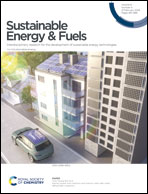Bifunctional Pt–Ir nanoparticle catalysts for oxygen reduction and evolution reactions: investigating the influence of surface composition on the catalytic properties†
Abstract
Unitized regenerative fuel cells (URFCs) can provide renewable, clean energy and hydrogen but require efficient bifunctional catalysts for oxygen reduction (ORR) and evolution reactions (OER). In this study, we present iridium-decorated platinum nanoparticles with three different compositions, Ir10/Pt90, Ir20/Pt80, and Ir40/Pt60. The nanoparticles' morphology and chemical structure were analysed before and after electrochemical activation to determine the optimal composition of the catalyst with the highest efficiency towards ORR and OER. Ir40/Pt60 showed the highest mass activity towards OER of 571.4 mA mgIr−1 at 1.525 VRHE, which was 1.5 times higher compared to commercial Ir black with 371.1 mA mgIr−1. In addition, the mass activity for ORR exhibited a positive correlation with the total of surface Pt active sites but decreased with the coverage of Pt nanoparticles by decorating Ir nanoparticles. Among the studied bimetallic nanoparticles, Ir20/Pt80 exhibited the highest efficiency at 57.7% and was considered the most promising URFC catalyst.



 Please wait while we load your content...
Please wait while we load your content...